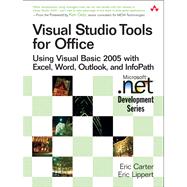Visual Studio Tools for Office is both the first and the definitive book on VSTO 2005 programming, written by the inventors of the technology. VSTO is a set of tools that allows professional developers to use the full power of Visual Studio .NET and the .NET Framework to put code behind Excel 2003, Word 2003, Outlook 2003, and InfoPath 2003.
VSTO provides functionality never before available to the Office developer: data binding and data/view separation, design-time views of Excel and Word documents inside Visual Studio, rich support for Windows Forms controls in a document, the ability to create custom Office task panes, server-side programming support against Office, and much more.
Carter and Lippert cover their subject matter with deft insight into the needs of .NET developers learning VSTO. This book
- Explains the architecture of Microsoft Office programming and introduces the object models
- Teaches the three basic patterns of Office solutions: Office automation executables, Office add-ins, and code behind a document
- Explores the ways of customizing Excel, Word, Outlook, and InfoPath, and plumbs the depths of programming with their events and object models
- Introduces the VSTO programming model
- Teaches how to use Windows Forms in VSTO and how to work with the Actions Pane
- Delves into VSTO data programming and server data scenarios
- Explores .NET code security and VSTO deployment








